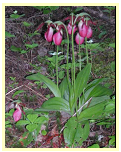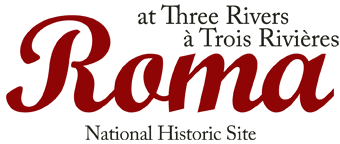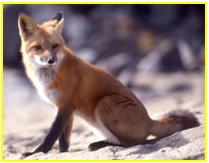
C The Bog Run
1.14 km. return., varied terrain, marked in blue on the map. (25 minute brisk walk)
The Bog Run is a trail leading to a lookout on the edge of a significant peat bog.
A pine grove on the route is a remnant of the large forest encountered by Roma in
1732. The bog ecosystem is unlike the rest of the site with characteristic wetland
trees, plants and insects. Watch for fireflies in late June and a variety of dragon-flies
all summer.
By-passes or Shortcuts ... varied terrain, marked in red on the map ...
Short cross-trails connect the River Trail on both sides of the site.
Diversions marked in pink on the map ... Diversions are rest areas overlooking the
Brudenell River or access points to the shore. They occur on the Heritage Trail
and the River Trail. Bring your camera.
1.14 km. return., varied terrain, marked in blue on the map. (25 minute brisk walk)
The Bog Run is a trail leading to a lookout on the edge of a significant peat bog.
A pine grove on the route is a remnant of the large forest encountered by Roma in
1732. The bog ecosystem is unlike the rest of the site with characteristic wetland
trees, plants and insects. Watch for fireflies in late June and a variety of dragon-flies
all summer.
By-passes or Shortcuts ... varied terrain, marked in red on the map ...
Short cross-trails connect the River Trail on both sides of the site.
Diversions marked in pink on the map ... Diversions are rest areas overlooking the
Brudenell River or access points to the shore. They occur on the Heritage Trail
and the River Trail. Bring your camera.



Island Trails Association
TRAIL DIRECTIONS

A The Heritage Trail
0.84 km.. loop, full access, 10 minute brisk walk ... longer to read the interpretive signs... marked in yellow on the map. The Heritage Trail is dedicated to French, Gaelic and English-speaking pioneers who settled and worked this land between 1732 and 1900. It leads into open woodland on a wide gravel surface. Delightful glades of Pink Lady's Slippers, the provincial flower in early June, and other colourful species illuminate the winding route. It follows the Brudenell River to where Roma and later the Macdonald brothers settled. Father of Confederation A.A. Macdonald, was born here in 1829.
0.84 km.. loop, full access, 10 minute brisk walk ... longer to read the interpretive signs... marked in yellow on the map. The Heritage Trail is dedicated to French, Gaelic and English-speaking pioneers who settled and worked this land between 1732 and 1900. It leads into open woodland on a wide gravel surface. Delightful glades of Pink Lady's Slippers, the provincial flower in early June, and other colourful species illuminate the winding route. It follows the Brudenell River to where Roma and later the Macdonald brothers settled. Father of Confederation A.A. Macdonald, was born here in 1829.
B The River Trail
3.15 km. loop, varied terrain, marked in white on the map.
The River Trail loop begins a short distance from the kiosk. Several open glades glisten with bright green mosses, flowers, blueberries or ferns in the morning dew. Pine needles carpet the path which climbs toward an elevated knoll that was once a cleared field. A drystone dyke crosses the trail, marking the old field edge. On the far side of the knoll the trail crosses bottomland where a creek from the central bog flows to the shore. The path follows the river to the northern tip of the property and then turns inland to return to the start.
3.15 km. loop, varied terrain, marked in white on the map.
The River Trail loop begins a short distance from the kiosk. Several open glades glisten with bright green mosses, flowers, blueberries or ferns in the morning dew. Pine needles carpet the path which climbs toward an elevated knoll that was once a cleared field. A drystone dyke crosses the trail, marking the old field edge. On the far side of the knoll the trail crosses bottomland where a creek from the central bog flows to the shore. The path follows the river to the northern tip of the property and then turns inland to return to the start.




Three Self Guided Woodland Walking Trails ...
Walk where French merchant Jean Pierre Roma carved a trading company out of the dense Acadian forest in the 1700s.
See where three Canadian Heritage Rivers meet.
Look for signs of a tunnel built by Roma to bring goods at water level from
the tall ships to his Company House.
Discover flowering woodland plants and shrubs.
Enjoy nature at the Jean Pierre Roma National Historic Site.
Walk where French merchant Jean Pierre Roma carved a trading company out of the dense Acadian forest in the 1700s.
See where three Canadian Heritage Rivers meet.
Look for signs of a tunnel built by Roma to bring goods at water level from
the tall ships to his Company House.
Discover flowering woodland plants and shrubs.
Enjoy nature at the Jean Pierre Roma National Historic Site.
A good starting point for the walking tour is north of the first parking lot. There is a trail head kiosk to the left of the first Heritage building. An alternate starting point is the parking lot by the water. Walk east, up the gravel road, to the point and then turn north at the National Historic Site monument.
The trails at Roma are cut through woodland at the tip of the peninsula between the Brudenell and Montague Canadian Heritage Rivers. The trails have interpretive signage and where two trails diverge, there is a confirmation map sign, "you are at this point."
The surface of the Heritage Trail is smooth, wide and flat with a base of trail mix gravel. The other paths are narrow and natural woodlot and you need to watch for exposed roots and rocks. Paths are not lighted and are not cleared of ice and snow. The viewing platform marked in the signage on The Bog Run still needs to be constructed.
The surface of the Heritage Trail is smooth, wide and flat with a base of trail mix gravel. The other paths are narrow and natural woodlot and you need to watch for exposed roots and rocks. Paths are not lighted and are not cleared of ice and snow. The viewing platform marked in the signage on The Bog Run still needs to be constructed.
TRAIL SMART TIPS
Travel the trails during daylight hours ...
Stay on the trails to avoid trampling low-lying vegetation
For safety, avoid going to the cliff edge by the river
Do not disturb wildlife
Leave flowers and plants for others to enjoy
Wear suitable clothing
Mosquito protection is a good idea in woodland
Walk with someone - it's safer and more fun
Pick up litter and deposit in the waste receptacles
at the Heritage buildings
Stay on the trails to avoid trampling low-lying vegetation
For safety, avoid going to the cliff edge by the river
Do not disturb wildlife
Leave flowers and plants for others to enjoy
Wear suitable clothing
Mosquito protection is a good idea in woodland
Walk with someone - it's safer and more fun
Pick up litter and deposit in the waste receptacles
at the Heritage buildings
Guided tours can be booked for special experiences and events.
For More Information
Three Rivers Roma Inc.
P.O. Box 758, Montague,
P.E.I. C0A 1R0 Canada
Telephone (902) 838-3413
www.roma3rivers.com
Three Rivers Roma Inc.
P.O. Box 758, Montague,
P.E.I. C0A 1R0 Canada
Telephone (902) 838-3413
www.roma3rivers.com
For more information on the history of the site, the book Jean Pierre Roma is available at $10.00 per copy in English and French.
PLANTS OF THE JEAN PIERRE ROMA HERITAGE WALKING TRAIL
Deciduous (leaf) Trees:
Red maple
White Birch
Grey birch
Large Tooth Aspen (Popular)
Trembling Aspen (Popular)
Willows
Speckled Alder
Mountain Ash (Dogberry,
Rowan Tree, Service Tree,
Witchwood)
Indian Pear (Saskatoon Berry)
Pin Cherry
Winter Berries
Red maple
White Birch
Grey birch
Large Tooth Aspen (Popular)
Trembling Aspen (Popular)
Willows
Speckled Alder
Mountain Ash (Dogberry,
Rowan Tree, Service Tree,
Witchwood)
Indian Pear (Saskatoon Berry)
Pin Cherry
Winter Berries
Coniferous (needle) Trees:
Balsam Fir
White Spruce
Black Spruce
Eastern white pine
Shrubs
Bayberry
Blueberry - low bush, wild
Dog wood - alternate leaf
Elderberry
Red berried elder
Wild Raisin
Balsam Fir
White Spruce
Black Spruce
Eastern white pine
Shrubs
Bayberry
Blueberry - low bush, wild
Dog wood - alternate leaf
Elderberry
Red berried elder
Wild Raisin
Woodland Flowers:
Bluebead Lily (Corn Lily)
Bunchberry
Devil's Paintbrush
Lady's Slippers
Lily of the Valley
Twin Flowers
Bluebead Lily (Corn Lily)
Bunchberry
Devil's Paintbrush
Lady's Slippers
Lily of the Valley
Twin Flowers
Ferns & Mosses
Sphagnum
Lichen Old Man's Beard
Fungus Mushrooms
In the cleared area
Wild carrot/Queen Anne's Lace
Golden rod
Dandeloin
Violets
Pussy Willows
Wild strawberry
Wild raspberry
Wild blackberry
Common apple
Grasses
Sphagnum
Lichen Old Man's Beard
Fungus Mushrooms
In the cleared area
Wild carrot/Queen Anne's Lace
Golden rod
Dandeloin
Violets
Pussy Willows
Wild strawberry
Wild raspberry
Wild blackberry
Common apple
Grasses
Animals
Snowshoe Hares
Red squirrel
Chipmunk
Foxes
Racoons
Skunks
Coyote
Snowshoe Hares
Red squirrel
Chipmunk
Foxes
Racoons
Skunks
Coyote
ANIMALS & BIRDS OF THE JEAN PIERRE ROMA TRAILS
Woodland birds:
Ruffled Grouse
Partridge
Bald Eagles
Blue Jays
Robin
Chickadee
Downy Woodpecker
Ravens
Ruffled Grouse
Partridge
Bald Eagles
Blue Jays
Robin
Chickadee
Downy Woodpecker
Ravens
Shore birds:
Great Blue Heron
Sea Gulls
Great Blue Heron
Sea Gulls


EXPERIENCING THE JEAN PIERRE ROMA TRAILS
What is your impression of your adventure?
Look - what are the sights that make you wonder?
Smell - what is dominant?
Listen, what are the sounds of the forest?
Feel the tree bark. How is the bark different on species of trees? Which are rough, smooth, ridged or shiny?
Discover which trees are family members? What are the distinct characteristics of each family?
Touch a coniferous tree branch. How do the needles feel?
Layers of the forest:
1. What plants are on the ground floor (undergrowth) of the forest?
2. What plant shrubs are mid-way up?
3. Which are the small trees?
4. Which are the tall trees?
Why are some trees falling down?
What is the effect of ladder trees?
Mystery - What is the value of dead trees and logs?
Lift a dead leaf - how does it benefit the ecosystem?
Do you see light filtering through a canopy opening?
Does the shady trail open on to a sunny glade?
Look closely. What birds are in the tree tops?
1. What plants are on the ground floor (undergrowth) of the forest?
2. What plant shrubs are mid-way up?
3. Which are the small trees?
4. Which are the tall trees?
Why are some trees falling down?
What is the effect of ladder trees?
Mystery - What is the value of dead trees and logs?
Lift a dead leaf - how does it benefit the ecosystem?
Do you see light filtering through a canopy opening?
Does the shady trail open on to a sunny glade?
Look closely. What birds are in the tree tops?
Habitat (a plant or animals natural home): What are the habitats on this trail? Find a plant or animals home (habitat).
The Heritage Trails lead through many habitats - dry forest, sandy beach and clearing. Just as people prefer certain places to live, so do plants. Which homeland do the plants prefer? Are there plants that would not normally grow here? What happens in the area exposed to wind compared to the one that is sheltered?
The Heritage Trails lead through many habitats - dry forest, sandy beach and clearing. Just as people prefer certain places to live, so do plants. Which homeland do the plants prefer? Are there plants that would not normally grow here? What happens in the area exposed to wind compared to the one that is sheltered?
Artistic Design:
What vistas (views from a forest opening) did you see?
What diversity is in the texture, patterns and density of the trail?
What variety of colours did you see in the bark, leaves, ground cover, shrubs, flowers and fruit?
Wild life:
Lift a leaf - did you see any insects?
Did you spot any animals? If no, why not?
What animals would find shelter in each layer of the forest?
Why would you not feed the birds and animals?
Wonder - what would pollinate the flowers?
What vistas (views from a forest opening) did you see?
What diversity is in the texture, patterns and density of the trail?
What variety of colours did you see in the bark, leaves, ground cover, shrubs, flowers and fruit?
Wild life:
Lift a leaf - did you see any insects?
Did you spot any animals? If no, why not?
What animals would find shelter in each layer of the forest?
Why would you not feed the birds and animals?
Wonder - what would pollinate the flowers?
Trails involve people:
What is the mood of the trail at the particular time of day, weather and season on your visit?
How does the trail make you feel?
What mystery still remains about the trail?
The people who came first:
Who were these people?
Why did they come here?
How did they clear the trees?
How do you think they felt?
What wood did the King of France want and why?
What is the mood of the trail at the particular time of day, weather and season on your visit?
How does the trail make you feel?
What mystery still remains about the trail?
The people who came first:
Who were these people?
Why did they come here?
How did they clear the trees?
How do you think they felt?
What wood did the King of France want and why?
Getting There and Back
On Rte #4, take Rte. #319. The site is located off Rte. 319, at 78 Roma Point Rd. Brudenell Pt., Prince Edward Island. The last 2.2km is a gravel road. The site is 8km north of Montague.
***
Three Rivers Roma Inc. is a Canadian registered tax-deductible non-profit charitable corporation.
It is run by a volunteer Board of Directors.
On Rte #4, take Rte. #319. The site is located off Rte. 319, at 78 Roma Point Rd. Brudenell Pt., Prince Edward Island. The last 2.2km is a gravel road. The site is 8km north of Montague.
***
Three Rivers Roma Inc. is a Canadian registered tax-deductible non-profit charitable corporation.
It is run by a volunteer Board of Directors.
FINDING THE JEAN PIERRE ROMA TRAILS
Lady's Slippers
Blooming Bunchberry

Hurricane Fiona
Fiona was not kind to Roma's Trails. The Heritage Trail is fully open. While the remaining Trails are now open, they are barely passable.